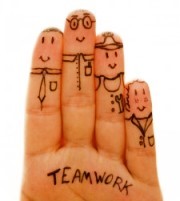Every progressive business owner and leader wants to inspire teamwork in their organization or department. But this is easier said than done.
In our training programs Style of Leadership and Team Development and My Team & I, we ask the question “what is the difference between a group and a team?
Undoubtedly, we get the answer that a team has a clear team goal whereas a group does not. While it is true that goals drive teamwork, a group of people working together can also have a common goal. Think of a large group of people working on designing and constructing a building. Everyone has the common goal of making the building, but they do not necessarily work as a team.
The Secret to Teamwork
 The crucial ingredient required to boost teamwork is team spirit. Many would argue that team spirit is the result of people working together towards a common goal. This is true if they can work together effectively and autonomously. To achieve this level of performance team members must want to help and support each other. They also need to learn specific interpersonal skills such as active listening, diplomatic disagreement, gently confrontation as well as problem solving and giving feedback,
The crucial ingredient required to boost teamwork is team spirit. Many would argue that team spirit is the result of people working together towards a common goal. This is true if they can work together effectively and autonomously. To achieve this level of performance team members must want to help and support each other. They also need to learn specific interpersonal skills such as active listening, diplomatic disagreement, gently confrontation as well as problem solving and giving feedback,
Self-knowledge and mutual understanding are also crucial elements in building team spirit. This creates greater acceptance and tolerance of others and forms the willingness to help and support one another.
The Leaders Role in Building Team Spirit
It’s the leader or managers’ role to assure that team members develop the interpersonal skills and have a worthwhile and challenging team goal or project.
Team training must include knowledge of oneself and others so that proper team spirit can be generated through training and other types of team activities.
Of course, the leader themselves must also partake of these types of learning and develop the attitude of continuous improvement in both people development and operational matters.
Achieving Higher Levels of Teamwork
When team members learn to help and support each other and work through their differences, greater levels of teamwork can be achieved. Teams that function at higher levels can take on greater responsibility and become more autonomous. This can allow the leader to delegate responsibility and spend more time on strategic issues.
Highly evolved teams can assume responsibilities such as hiring and training new team members, practicing problem solving for continuous improvement and participating in managing an operating budget for their team or department. Teams of this type are often called interdependent or fully functioning teams.
Assess Team Effectiveness
How dependent on their leader are team members? How well do team members know and trust each other? Do they have team spirit? Do they have a common goal? Do the accept and support each other? Can they resolve conflicts on their own? Do they solve problems as a team? Do they practice continuous improvement?
Act to Inspire Teamwork
Rate your team for each item below on a scale of 1 to 5. Where would you like to see your team in six months or a year from now? What can you do to improve? What changes or improvements do you need to make as a leader? You can use the grid below or download this as a form. Have your team complete this as well and compare each others’ perception.
Teamwork Effectiveness Evaluation Worksheet
| Item | Criteria | Leaders rating 1 = disagree 5 = agree | Team member 1 = disagree 5 = agree | Gap in perception |
| 1 | Team members act independently to complete tasks and make decisions | 1 – 2 – 3- 4- 5 | 1 – 2 – 3- 4- 5 | |
| 2 | Team members readily help and support each other | 1 – 2 – 3- 4- 5 | 1 – 2 – 3- 4- 5 | |
| 3 | Team members know and trust each other? | 1 – 2 – 3- 4- 5 | 1 – 2 – 3- 4- 5 | |
| 4 | Team spirit prevails | 1 – 2 – 3- 4- 5 | 1 – 2 – 3- 4- 5 | |
| 5 | The team has a common goal or project | 1 – 2 – 3- 4- 5 | 1 – 2 – 3- 4- 5 | |
| 6 | Team members confront each other positively and resolve conflicts independently | 1 – 2 – 3- 4- 5 | 1 – 2 – 3- 4- 5 | |
| 7 | The team practices problem solving on their own | 1 – 2 – 3- 4- 5 | 1 – 2 – 3- 4- 5 | |
| 8 | The team engages in continuous improvement | 1 – 2 – 3- 4- 5 | 1 – 2 – 3- 4- 5 | |
| Total score out of possible 40 |
Set a Goal for Improvement
Get going now with you action plan. Use my goal setting process to work on this. Make it a priority if you want real teamwork and team spirit to grow in your organization or department.